Modelling Land Sharing and Land Sparing Relationship with Rural Population in the Cerrado
Abstract
:1. Introduction
2. Materials and Methods
2.1. Study Area
2.2. Land Sharing Index
2.3. Gridded Population Data
2.4. Spatial Analysis
3. Results
3.1. Land Sharing/Sparing Index
3.2. Rural Population Disaggregation
3.3. LSS and Rural Population
4. Discussion
4.1. Spatial Analysis
4.2. Land Sharing/Sparing in the Cerrado
5. Conclusions
Author Contributions
Funding
Acknowledgments
Conflicts of Interest
References
- Ellis, E.C.; Klein Goldewijk, K.; Siebert, S.; Lightman, D.; Ramankutty, N. Anthropogenic transformation of the biomes, 1700 to 2000. Glob. Ecol. Biogeogr. 2010, 19, 589–606. [Google Scholar] [CrossRef]
- Erb, K.H.; Luyssaert, S.; Meyfroidt, P.; Pongratz, J.; Don, A.; Kloster, S.; Kuemmerle, T.; Fetzel, T.; Fuchs, R.; Herold, M.; et al. Land management: Data availability and process understanding for global change studies. Glob. Chang. Biol. 2017, 23, 512–533. [Google Scholar] [CrossRef] [PubMed]
- Food and Agriculture Organization (FAO). State of the World’s Forests 2016. Forests and Agriculture: Land-Use Challenges and Opportunities; Food and Agriculture Organization: Rome, Italy, 2016. [Google Scholar]
- Ramankutty, N.; Mehrabi, Z.; Waha, K.; Jarvis, L.; Kremen, C.; Herrero, M.; Rieseberg, L.H. Trends in global agricultural land use: implications for environmental health and food security. Ann. Rev. Plant Biol. 2018, 69, 789–815. [Google Scholar] [CrossRef] [PubMed]
- Ceballos, G.; Ehrlich, P.R.; Barnosky, A.D.; García, A.; Pringle, R.M.; Palmer, T.M. Accelerated modern human–induced species losses: Entering the sixth mass extinction. Sci. Adv. 2015, 1, e1400253. [Google Scholar] [CrossRef] [PubMed] [Green Version]
- Smith, P.; Bustamante, M.; Ahammad, H.; Clark, H.; Dong, H.; Elsiddig, E.A.; Haberl, H.; Harper, R.; House, J.; Jafari, M.; et al. Agriculture, Forestry and Other Land Use (AFOLU). In Climate Change 2014: Mitigation of Climate Change. Contribution of Working Group Iii to the Fifth Assessment Report of the Intergovernmental Panel on Climate Change; Cambridge University Press: Cambridge, UK, 2014. [Google Scholar]
- Stehle, S.; Schulz, R. Agricultural insecticides threaten surface waters at the global scale. Proc. Natl. Acad. Sci. USA 2015, 112, 5750–5755. [Google Scholar] [CrossRef] [PubMed] [Green Version]
- Walker, L.; Wu, S. Pollinators and pesticides. In International Farm Animal, Wildlife and Food Safety Law; Springer: Berlin, Germany, 2017; pp. 495–513. [Google Scholar]
- Bombardi, L.M. Geography of the Use of Agrochemicals in Brazil and Connections with the European Union; FFLCH–USP: São Paulo, Brazil, 2017. [Google Scholar]
- Popp, J.; Kot, S.; Lakner, Z.; Oláh, J. Biofuel use: Peculiarities and Implications. J. Secur. Sustain. Issues 2018, 7, 3. [Google Scholar] [CrossRef]
- Langeveld, J.W.; Dixon, J.; van Keulen, H.; Quist-Wessel, P.F. Analyzing the effect of biofuel expansion on land use in major producing countries: evidence of increased multiple cropping. Biofuels Bioprod. Biorefining 2014, 8, 49–58. [Google Scholar] [CrossRef]
- Popp, J.; Lakner, Z.; Harangi-Rakos, M.; Fari, M. The effect of bioenergy expansion: Food, energy, and environment. Renew. Sustain. Energy Rev. 2014, 32, 559–578. [Google Scholar] [CrossRef]
- Garnett, T.; Appleby, M.; Balmford, A.; Bateman, I.; Benton, T.; Bloomer, P.; Burlingame, B.; Dawkins, M.; Dolan, L.; Fraser, D.; et al. Sustainable intensification in agriculture: Premises and policies. Science 2013, 341, 33–34. [Google Scholar] [CrossRef] [PubMed] [Green Version]
- Smith, P. Delivering food security without increasing pressure on land. Glob. Food Secur. 2013, 2, 18–23. [Google Scholar] [CrossRef]
- Kremen, C. Reframing the land-sparing/land-sharing debate for biodiversity conservation. Ann. N. Y. Acad. Sci. 2015, 1355, 52–76. [Google Scholar] [CrossRef] [PubMed] [Green Version]
- Phalan, B.; Balmford, A.; Green, R.E.; Scharlemann, J.P. Minimising the harm to biodiversity of producing more food globally. Food Policy 2011, 36, S62–S71. [Google Scholar] [CrossRef]
- Altieri, M.A. The ecological role of biodiversity in agroecosystems. Agric. Ecosyst. Environ. 1999, 74, 19–31. [Google Scholar] [CrossRef] [Green Version]
- Vandermeer, J.; Perfecto, I. The agricultural matrix and a future paradigm for conservation. Conserv. Biol. 2007, 21, 274–277. [Google Scholar] [CrossRef] [PubMed]
- Geiger, F.; Bengtsson, J.; Berendse, F.; Weisser, W.W.; Emmerson, M.; Morales, M.B.; Ceryngier, P.; Liira, J.; Tscharntke, T.; Winqvist, C.; et al. Persistent negative effects of pesticides on biodiversity and biological control potential on European farmland. Basic Appl. Ecol. 2010, 11, 97–105. [Google Scholar] [CrossRef]
- Winqvist, C.; Ahnström, J.; Bengtsson, J. Effects of organic farming on biodiversity and ecosystem services: Taking landscape complexity into account. Ann. N. Y. Acad. Sci. 2012, 1249, 191–203. [Google Scholar] [CrossRef] [PubMed]
- Balmford, A.; Green, R.; Scharlemann, J.P. Sparing land for nature: Exploring the potential impact of changes in agricultural yield on the area needed for crop production. Glob. Chang. Biol. 2005, 11, 1594–1605. [Google Scholar] [CrossRef]
- Green, R.E.; Cornell, S.J.; Scharlemann, J.P.; Balmford, A. Farming and the fate of wild nature. Science 2005, 307, 550–555. [Google Scholar] [CrossRef] [PubMed]
- Clough, Y.; Barkmann, J.; Juhrbandt, J.; Kessler, M.; Wanger, T.C.; Anshary, A.; Buchori, D.; Cicuzza, D.; Darras, K.; Putra, D.D.; et al. Combining high biodiversity with high yields in tropical agroforests. Proc. Natl. Acad. Sci. USA 2011, 108, 8311–8316. [Google Scholar] [CrossRef] [PubMed] [Green Version]
- Phalan, B.; Onial, M.; Balmford, A.; Green, R.E. Reconciling food production and biodiversity conservation: Land sharing and land sparing compared. Science 2011, 333, 1289–1291. [Google Scholar] [CrossRef] [PubMed]
- Fischer, J.; Batáry, P.; Bawa, K.S.; Brussaard, L.; Chappell, M.J.; Clough, Y.; Daily, G.C.; Dorrough, J.; Hartel, T.; Jackson, L.E.; et al. Conservation: Limits of land sparing. Science 2011, 334, 593. [Google Scholar] [CrossRef] [PubMed]
- Tscharntke, T.; Clough, Y.; Wanger, T.C.; Jackson, L.; Motzke, I.; Perfecto, I.; Vandermeer, J.; Whitbread, A. Global food security, biodiversity conservation and the future of agricultural intensification. Biol. Conserv. 2012, 151, 53–59. [Google Scholar] [CrossRef]
- Chandler, R.B.; King, D.I.; Raudales, R.; Trubey, R.; Chandler, C.; Arce Chávez, V.J. A Small-Scale Land-Sparing Approach to Conserving Biological Diversity in Tropical Agricultural Landscapes. Conserv. Biol. 2013, 27, 785–795. [Google Scholar] [CrossRef] [PubMed]
- Gabriel, D.; Sait, S.M.; Kunin, W.E.; Benton, T.G. Food production vs. biodiversity: Comparing organic and conventional agriculture. J. Appl. Ecol. 2013, 50, 355–364. [Google Scholar] [CrossRef]
- Mendenhall, C.D.; Archer, H.M.; Brenes, F.O.; Sekercioglu, C.H.; Sehgal, R.N. Balancing biodiversity with agriculture: Land sharing mitigates avian malaria prevalence. Conserv. Lett. 2013, 6, 125–131. [Google Scholar] [CrossRef] [Green Version]
- Von Wehrden, H.; Abson, D.J.; Beckmann, M.; Cord, A.F.; Klotz, S.; Seppelt, R. Realigning the land-sharing/land-sparing debate to match conservation needs: Considering diversity scales and land-use history. Landsc. Ecol. 2014, 29, 941–948. [Google Scholar] [CrossRef]
- Fischer, J.; Abson, D.J.; Butsic, V.; Chappell, M.J.; Ekroos, J.; Hanspach, J.; Kuemmerle, T.; Smith, H.G.; Wehrden, H. Land sparing versus land sharing: Moving forward. Conserv. Lett. 2014, 7, 149–157. [Google Scholar] [CrossRef]
- Gonthier, D.J.; Ennis, K.K.; Farinas, S.; Hsieh, H.Y.; Iverson, A.L.; Batáry, P.; Rudolphi, J.; Tscharntke, T.; Cardinale, B.J.; Perfecto, I. Biodiversity conservation in agriculture requires a multi-scale approach. Proc. R. Soc. Lond. B Biol. Sci. 2014, 281, 20141358. [Google Scholar] [CrossRef] [PubMed]
- Hodgson, J.A.; Kunin, W.E.; Thomas, C.D.; Benton, T.G.; Gabriel, D. Comparing organic farming and land sparing: Optimizing yield and butterfly populations at a landscape scale. Ecol. Lett. 2010, 13, 1358–1367. [Google Scholar] [CrossRef] [PubMed]
- Fischer, J.; Brosi, B.; Daily, G.C.; Ehrlich, P.R.; Goldman, R.; Goldstein, J.; Lindenmayer, D.B.; Manning, A.D.; Mooney, H.A.; Pejchar, L.; et al. Should agricultural policies encourage land sparing or wildlife-friendly farming? Front. Ecol. Environ. 2008, 6, 380–385. [Google Scholar] [CrossRef]
- Luskin, M.S.; Lee, J.S.; Edwards, D.P.; Gibson, L.; Potts, M.D. Study context shapes recommendations of land-sparing and sharing; A quantitative review. Glob. Food Secur. 2017, 16, 29–35. [Google Scholar] [CrossRef]
- Jiang, G.; Wang, G.; Holyoak, M.; Yu, Q.; Jia, X.; Guan, Y.; Bao, H.; Hua, Y.; Zhang, M.; Ma, J. Land sharing and land sparing reveal social and ecological synergy in big cat conservation. Biol. Conserv. 2017, 211, 142–149. [Google Scholar] [CrossRef]
- Edwards, D.P.; Gilroy, J.J.; Woodcock, P.; Edwards, F.A.; Larsen, T.H.; Andrews, D.J.; Derhé, M.A.; Docherty, T.D.; Hsu, W.W.; Mitchell, S.L.; et al. Land-sharing versus land-sparing logging: Reconciling timber extraction with biodiversity conservation. Glob. Chang. Biol. 2014, 20, 183–191. [Google Scholar] [CrossRef] [PubMed]
- Pywell, R.F.; Heard, M.S.; Woodcock, B.A.; Hinsley, S.; Ridding, L.; Nowakowski, M.; Bullock, J.M. Wildlife-friendly farming increases crop yield: Evidence for ecological intensification. Proc. R. Soc. B 2015, 282, 20151740. [Google Scholar] [CrossRef] [PubMed]
- Miller, J.R. Biodiversity conservation and the extinction of experience. Trends Ecol. Evol. 2005, 20, 430–434. [Google Scholar] [CrossRef] [PubMed]
- Folke, C.; Jansson, Å.; Rockström, J.; Olsson, P.; Carpenter, S.R.; Chapin, F.S., III; Crépin, A.S.; Daily, G.; Danell, K.; Ebbesson, J.; et al. Reconnecting to the biosphere. Ambio 2011, 40, 719–738. [Google Scholar] [CrossRef] [PubMed]
- Aide, T.M.; Grau, H.R. Globalization, migration, and Latin American ecosystems. Science 2004, 305, 1915–1916. [Google Scholar] [CrossRef] [PubMed]
- Wright, S.J.; Muller-Landau, H.C. The future of tropical forest species1. Biotropica 2006, 38, 287–301. [Google Scholar] [CrossRef]
- Perfecto, I.; Vandermeer, J. The agroecological matrix as alternative to the land-sparing/agriculture intensification model. Proc. Natl. Acad. Sci. USA 2010, 107, 5786–5791. [Google Scholar] [CrossRef] [PubMed] [Green Version]
- Figueiredo, A.A. Food production and the food industry in Brazil: Their impact on nutritional status. Food Rev. Int. 1989, 5, 237–250. [Google Scholar] [CrossRef]
- Ruel, M.T.; Garrett, J.; Yosef, S.; Olivier, M. Urbanization, food security and nutrition. In Nutrition and Health in a Developing World; Springer: Berlin. Germany, 2017; pp. 705–735. [Google Scholar]
- Vandermeer, J.; van Noordwijk, M.; Anderson, J.; Ong, C.; Perfecto, I. Global change and multi-species agroecosystems: Concepts and issues. Agric. Ecosyst. Environ. 1998, 67, 1–22. [Google Scholar] [CrossRef]
- Altieri, M.A.; Funes-Monzote, F.R.; Petersen, P. Agroecologically efficient agricultural systems for smallholder farmers: Contributions to food sovereignty. Agron. Sustain. Dev. 2012, 32, 1–13. [Google Scholar] [CrossRef]
- Garibaldi, L.A.; Gemmill-Herren, B.; D?Annolfo, R.; Graeub, B.E.; Cunningham, S.A.; Breeze, T.D. Farming approaches for greater biodiversity, livelihoods, and food security. Trends Ecol. Evol. 2017, 32, 68–80. [Google Scholar] [CrossRef] [PubMed]
- Berkes, F. Rethinking community-based conservation. Conserv. Biol. 2004, 18, 621–630. [Google Scholar] [CrossRef]
- Tscharntke, T.; Klein, A.M.; Kruess, A.; Steffan-Dewenter, I.; Thies, C. Landscape perspectives on agricultural intensification and biodiversity–ecosystem service management. Ecol. Lett. 2005, 8, 857–874. [Google Scholar] [CrossRef]
- Lin, B.B. Resilience in agriculture through crop diversification: adaptive management for environmental change. BioScience 2011, 61, 183–193. [Google Scholar] [CrossRef]
- Larsen, A.E.; Gaines, S.D.; Deschênes, O. Spatiotemporal variation in the relationship between landscape simplification and insecticide use. Ecol. Appl. 2015, 25, 1976–1983. [Google Scholar] [CrossRef] [PubMed]
- Chappell, M.J.; LaValle, L.A. Food security and biodiversity: Can we have both? An agroecological analysis. Agric. Human Values 2011, 28, 3–26. [Google Scholar] [CrossRef]
- Lahsen, M.; Bustamante, M.M.; Dalla-Nora, E.L. Undervaluing and overexploiting the Brazilian Cerrado at our peril. Environ. Sci. Policy Sustain. Dev. 2016, 58, 4–15. [Google Scholar] [CrossRef]
- Myers, N.; Mittermeier, R.A.; Mittermeier, C.G.; Da Fonseca, G.A.; Kent, J. Biodiversity hotspots for conservation priorities. Nature 2000, 403, 853–858. [Google Scholar] [CrossRef] [PubMed]
- Ministério do Meio Ambiente. Mapeamento do Uso e Cobertura do Cerrado: Projeto Terra Class Cerrado; Ministério do Meio Ambiente: Brasília, Brazil, 2015. [Google Scholar]
- Ganem, R.S.; Drummond, J.A.; Franco, J.L.d.A. Conservation polices and control of habitat fragmentation in the Brazilian Cerrado biome. Ambient. Soc. 2013, 16, 99–118. [Google Scholar] [CrossRef]
- De Oliveira D’Antona, Á.; Bueno, M.d.C.D.; de Sampaio Dagnino, R. Estimativa da população em unidades de conservação na Amazônia Legal brasileira–uma aplicação de grades regulares a partir da Contagem 2007. Rev. Bras. Estud. Pop. 2013, 30, 401–428. [Google Scholar]
- Amaral, S.; Gavlak, A.A.; Escada, M.I.S.; Monteiro, A.M.V. Using remote sensing and census tract data to improve representation of population spatial distribution: Case studies in the Brazilian Amazon. Popul. Environ. 2012, 34, 142–170. [Google Scholar] [CrossRef]
- Tammisto, R. Merging national population grids (bottom-up approach) into a European dataset. In GIS for Statistics; Anais: Luxembourg, 2007. [Google Scholar]
- Smith, M.J.; Goodchild, M.F.; Longley, P. Geospatial Analysis: A Comprehensive Guide to Principles, Techniques and Software Tools; Troubador Publishing Ltd.: Leicester, UK, 2007. [Google Scholar]
- Anselin, L. Local indicators of spatial association—LISA. Geogr. Anal. 1995, 27, 93–115. [Google Scholar] [CrossRef]
- Gilbert, A.; Chakraborty, J. Using geographically weighted regression for environmental justice analysis: Cumulative cancer risks from air toxics in Florida. Soc. Sci. Res. 2011, 40, 273–286. [Google Scholar] [CrossRef]
- Fotheringham, A.S.; Brunsdon, C.; Charlton, M. Geographically Weighted Regression; John Wiley & Sons Ltd.: West Atrium, Canada, 2003. [Google Scholar]
- Finley, A.O. Comparing spatially-varying coefficients models for analysis of ecological data with non-stationary and anisotropic residual dependence. Methods Ecol. Evol. 2011, 2, 143–154. [Google Scholar] [CrossRef]
- Brunsdon, C.; Fotheringham, A.; Charlton, M. Geographically weighted summary statistics: A framework for localised exploratory data analysis. Comput. Environ. Urban Syst. 2002, 26, 501–524. [Google Scholar] [CrossRef]
- Faraway, J.J. Practical Regression and ANOVA Using R. 2002. Available online: http://cran.r-project.org/doc/contrib/Faraway-PRA.pdf (accessed on 20 July 2018).
- Benitez, F.L.; Anderson, L.O.; Formaggio, A.R. Evaluation of geostatistical techniques to estimate the spatial distribution of aboveground biomass in the Amazon rainforest using high-resolution remote sensing data. Acta Amazon. 2016, 46, 151–160. [Google Scholar] [CrossRef] [Green Version]
- Klink, C.A.; Moreira, A.G. Past and current human occupation, and land use. Cerrados Braz. Ecol. Natl. Hist. Neot. Savanna 2002, 5, 69–90. [Google Scholar]
- Ojima, R.; Martine, G. Resgates sobre População e Ambiente: Breve análise da Dinâmica Demográfica e a Urbanização nos Biomas Brasileiros. Idéias 2012, 3, 5. [Google Scholar] [CrossRef]
- Brunsdon, C.; Fotheringham, S.; Charlton, M. Geographically weighted regression. J. R. Stat. Soc. Ser. D 1998, 47, 431–443. [Google Scholar] [CrossRef]
- Spera, S.A.; Galford, G.L.; Coe, M.T.; Macedo, M.N.; Mustard, J.F. Land-use change affects water recycling in Brazil’s last agricultural frontier. Glob. Chang. Biol. 2016, 22, 3405–3413. [Google Scholar] [CrossRef] [PubMed]
- Aguiar, A.S. Modelagem da DinÂmica do Desmatamento Na RegiÃo do MATOPIBA Até 2050. Master’s Dissertation, Universidade de Brasilia (UNB), Brasilia, Brazil, 2016. [Google Scholar]
- Silva, R.F.B.d.; Batistella, M.; Dou, Y.; Moran, E.; Torres, S.M.; Liu, J. The Sino-Brazilian telecoupled soybean system and cascading effects for the exporting country. Land 2017, 6, 53. [Google Scholar] [CrossRef]
- Fotheringham, A.S.; Crespo, R.; Yao, J. Geographical and temporal weighted regression (GTWR). Geogr. Anal. 2015, 47, 431–452. [Google Scholar] [CrossRef]
- Fotheringham, A.S.; Yang, W.; Kang, W. Multiscale Geographically Weighted Regression (MGWR). Ann. Am. Assoc. Geogr. 2017, 107, 1247–1265. [Google Scholar] [CrossRef]
- Silva, A.J.; do Socorro Lira Monteiro, M.; Barbosa, E.L. New productive dynamics and old territorial issues in the northern cerrados from Brazil. Espacios 2015, 36, 14–22. [Google Scholar]
- Ewers, R.M.; Scharlemann, J.P.; Balmford, A.; Green, R.E. Do increases in agricultural yield spare land for nature? Glob. Chang. Biol. 2009, 15, 1716–1726. [Google Scholar] [CrossRef] [Green Version]
- Rudel, T.K.; Schneider, L.; Uriarte, M.; Turner, B.L.; DeFries, R.; Lawrence, D.; Geoghegan, J.; Hecht, S.; Ickowitz, A.; Lambin, E.F.; et al. Agricultural intensification and changes in cultivated areas, 1970–2005. Proc. Natl. Acad. Sci. USA 2009, 106, 20675–20680. [Google Scholar] [CrossRef] [PubMed]
- Lapola, D.M.; Martinelli, L.A.; Peres, C.A.; Ometto, J.P.; Ferreira, M.E.; Nobre, C.A.; Aguiar, A.P.D.; Bustamante, M.M.; Cardoso, M.F.; Costa, M.H.; et al. Pervasive transition of the Brazilian land-use system. Nat. Clim. Chang. 2014, 4, 27–35. [Google Scholar] [CrossRef]
- Dias, L.C.; Pimenta, F.M.; Santos, A.B.; Costa, M.H.; Ladle, R.J. Patterns of land use, extensification, and intensification of Brazilian agriculture. Glob. Chang. Biol. 2016, 22, 2887–2903. [Google Scholar] [CrossRef] [PubMed]
- Strassburg, B.B.; Brooks, T.; Feltran-Barbieri, R.; Iribarrem, A.; Crouzeilles, R.; Loyola, R.; Latawiec, A.E.; Oliveira Filho, F.J.; Scaramuzza, C.A.d.M.; Scarano, F.R.; et al. Moment of truth for the Cerrado hotspot. Nat. Ecol. Evol. 2017, 1, 0099. [Google Scholar] [CrossRef] [PubMed]
- Soares-Filho, B.; Alencar, A.; Nepstad, D.; Cerqueira, G.; Diaz, V.; del Carmen, M.; Rivero, S.; Solorzano, L.; Voll, E. Simulating the response of land-cover changes to road paving and governance along a major Amazon highway: the Santarém–Cuiabá corridor. Glob. Chang. Biol. 2004, 10, 745–764. [Google Scholar] [CrossRef]
- Alves, D.S. Space-time dynamics of deforestation in Brazilian Amazonia. Int. J. Remote Sens. 2002, 23, 2903–2908. [Google Scholar] [CrossRef]
- Jusys, T. Fundamental causes and spatial heterogeneity of deforestation in Legal Amazon. Appl. Geogr. 2016, 75, 188–199. [Google Scholar] [CrossRef]
- Brondizio, E.S.; Le Tourneau, F.M. Environmental governance for all. Science 2016, 352, 1272–1273. [Google Scholar] [CrossRef] [PubMed]
- Stephens, P.A. Land sparing, land sharing, and the fate of Africa?s lions. Proc. Natl. Acad. Sci. USA 2015, 112, 14753–14754. [Google Scholar] [CrossRef] [PubMed] [Green Version]

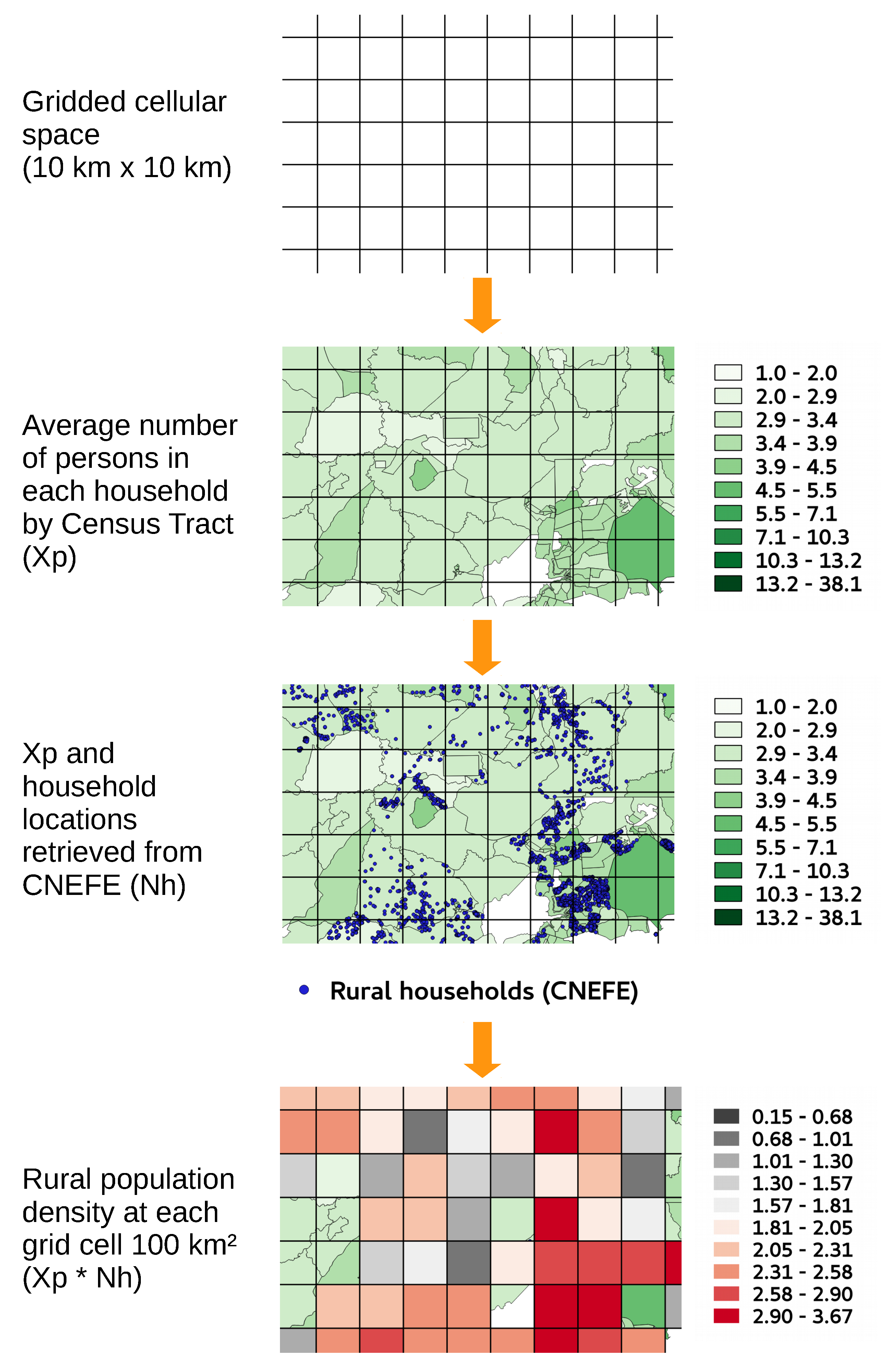

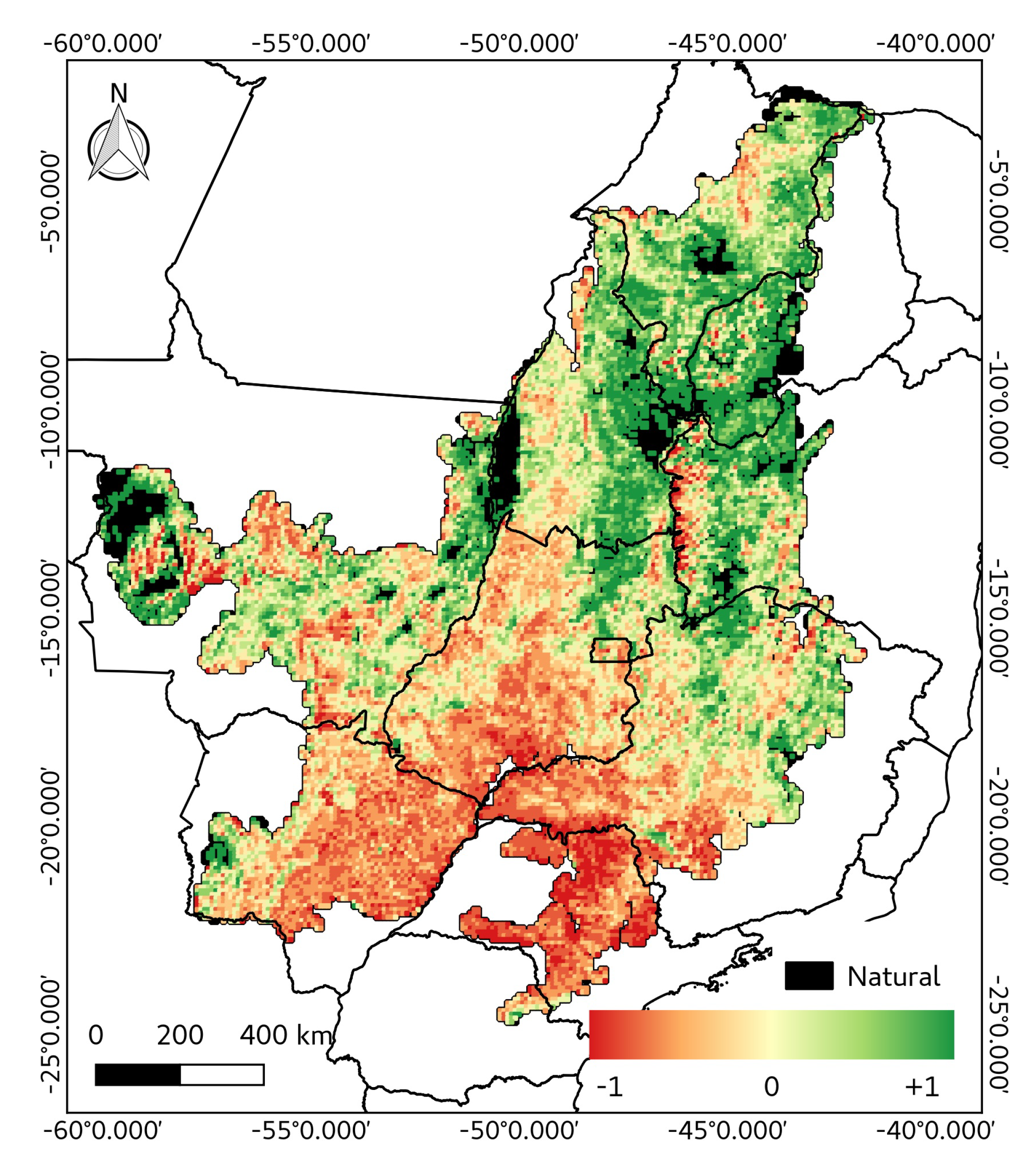
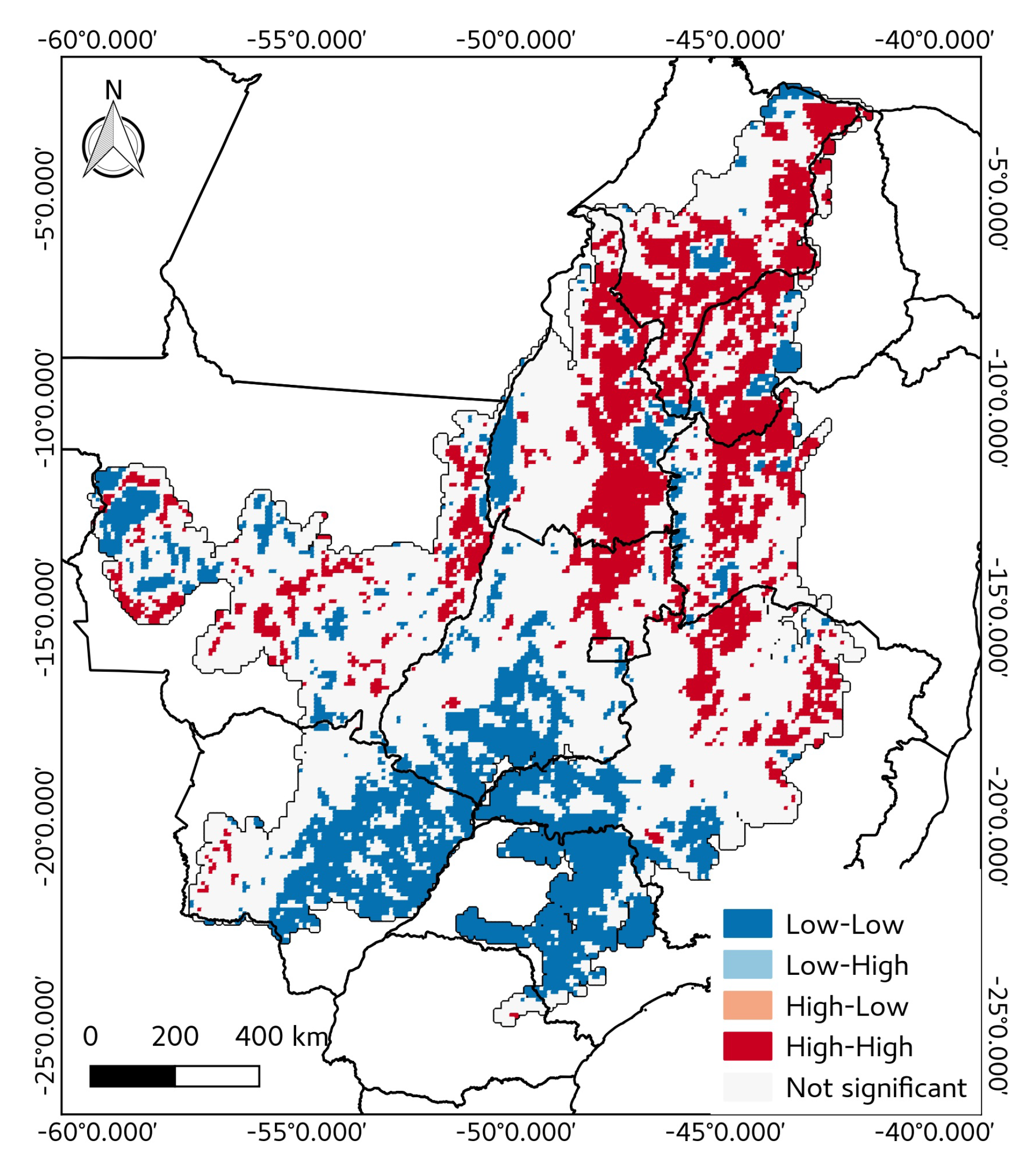

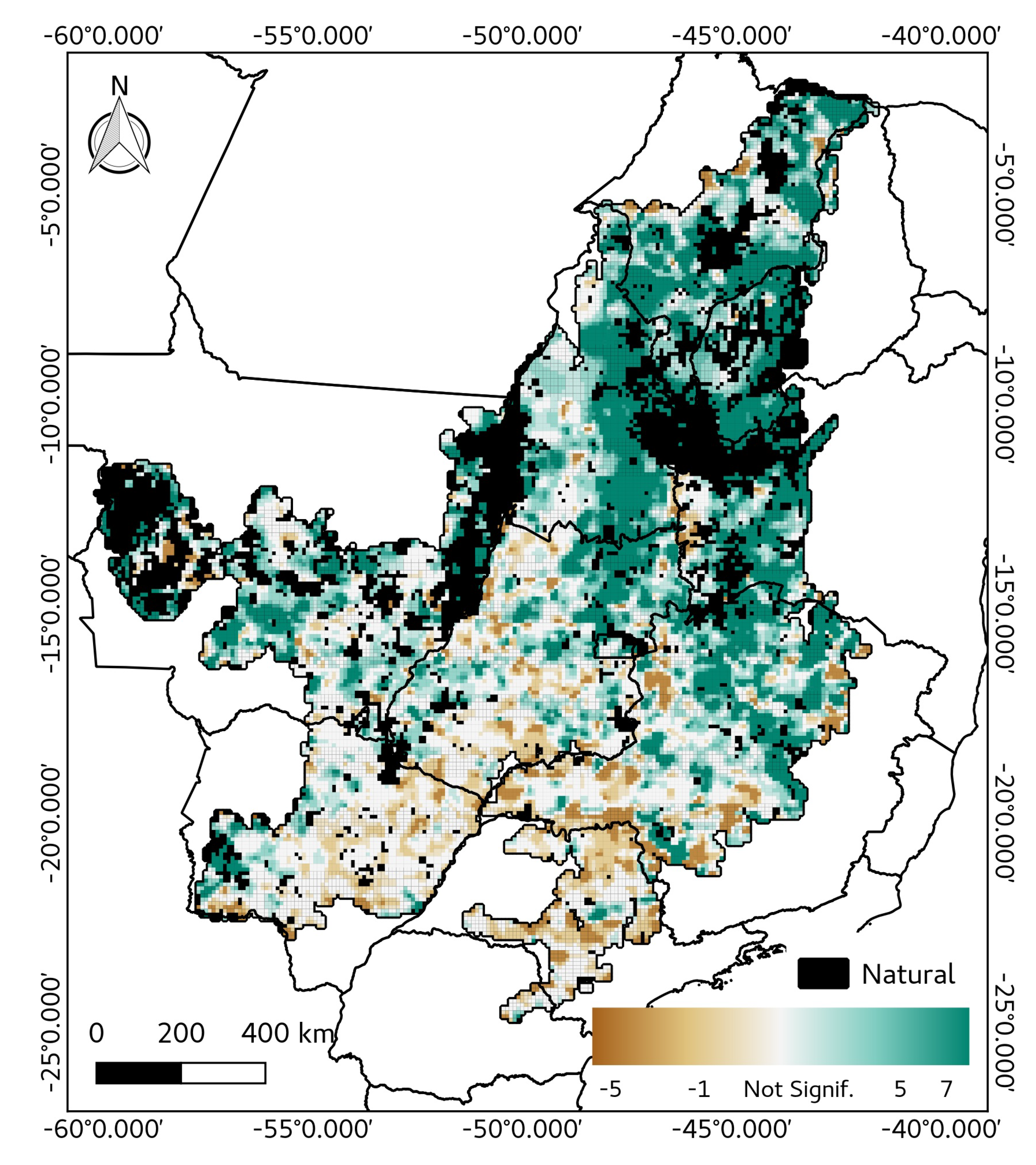
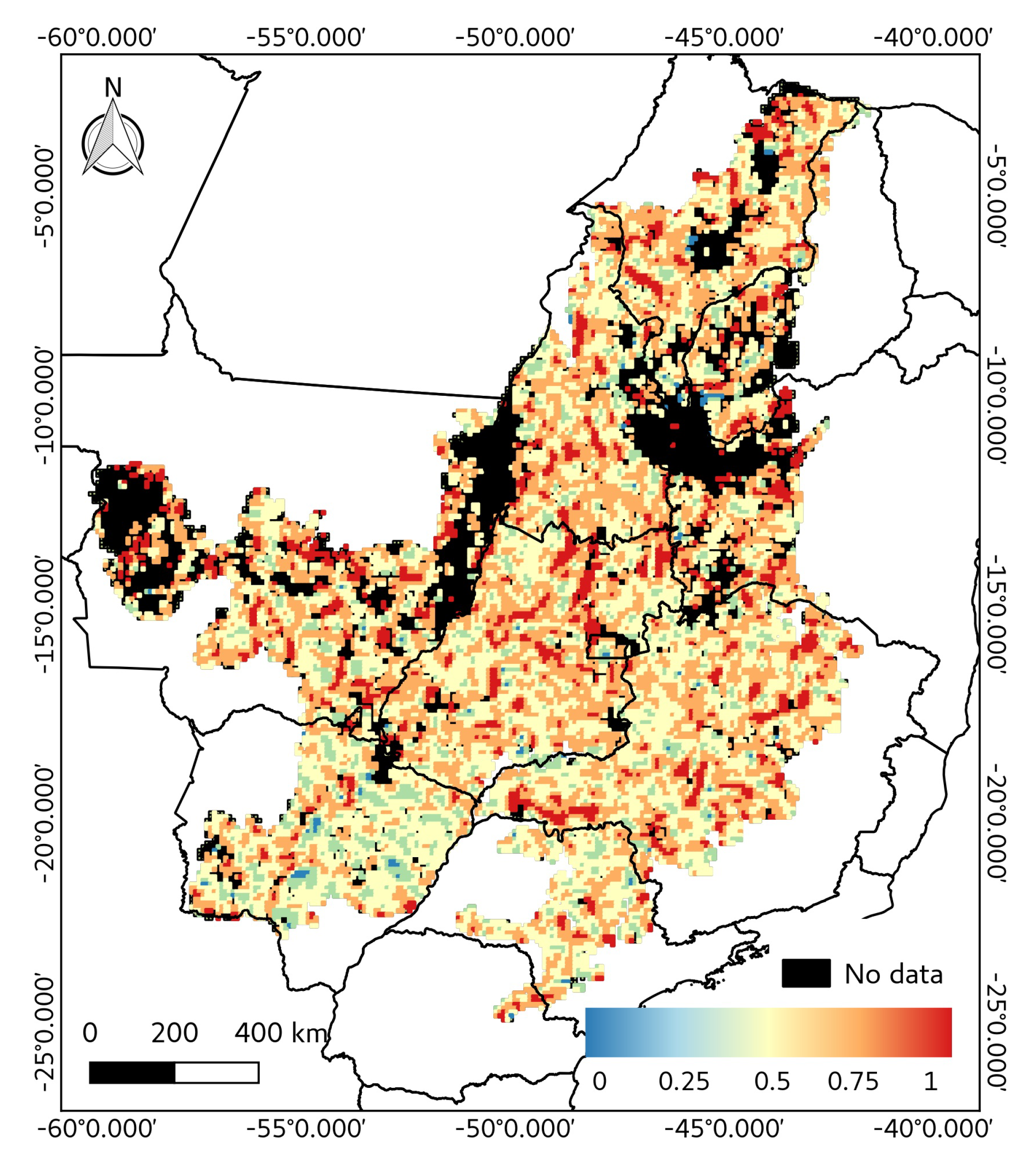
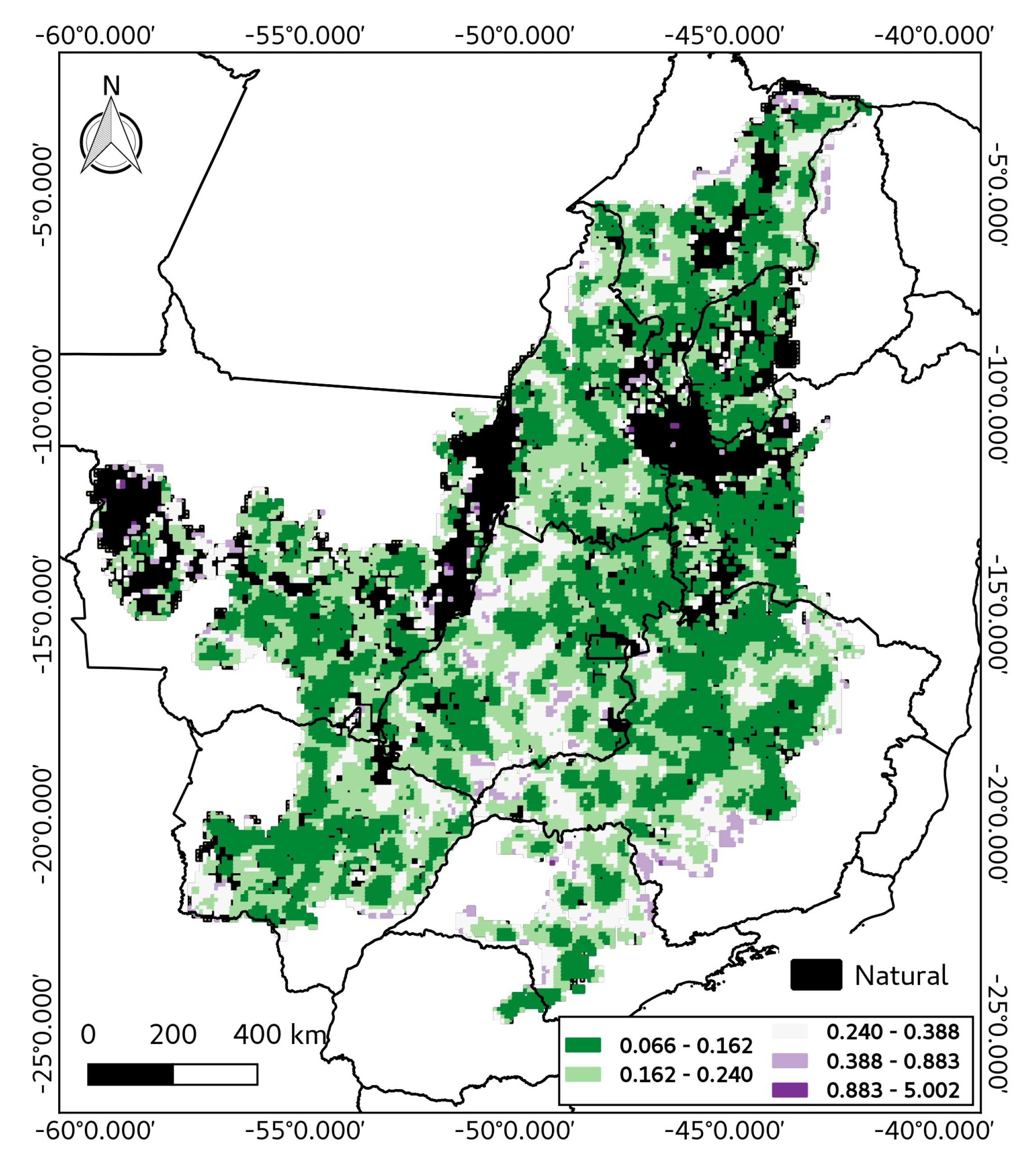
| Class | Area (km) | % | |
|---|---|---|---|
| Anthropogenic land use | Permanent crops * | 174,006 | 8.53 |
| Temporary crops * | 64,512 | 3.16 | |
| Mining | 247 | 0.01 | |
| Occupation mosaic | 2326 | 0.11 | |
| Pasture * | 600,832 | 29.46 | |
| Silviculture * | 30,525 | 1.50 | |
| Bare soil | 3621 | 0.18 | |
| Urban area | 8797 | 0.43 | |
| Other | 73 | 0.00 | |
| Total anthropogenic | 884,939 | 43.38 | |
| Natural | Forest | 418,789 | 20.54 |
| Non-forest | 692,301 | 33.95 | |
| Non-vegetated | 2609 | 0.13 | |
| Total natural | 1,113,699 | 54.62 | |
| Water bodies | 15,056 | 0.74 | |
| Not observed | 25,549 | 1.25 | |
| Total | 2,039,243 | 100 |
© 2018 by the authors. Licensee MDPI, Basel, Switzerland. This article is an open access article distributed under the terms and conditions of the Creative Commons Attribution (CC BY) license (http://creativecommons.org/licenses/by/4.0/).
Share and Cite
Pompeu, J.; Soler, L.; Ometto, J. Modelling Land Sharing and Land Sparing Relationship with Rural Population in the Cerrado. Land 2018, 7, 88. https://doi.org/10.3390/land7030088
Pompeu J, Soler L, Ometto J. Modelling Land Sharing and Land Sparing Relationship with Rural Population in the Cerrado. Land. 2018; 7(3):88. https://doi.org/10.3390/land7030088
Chicago/Turabian StylePompeu, João, Luciana Soler, and Jean Ometto. 2018. "Modelling Land Sharing and Land Sparing Relationship with Rural Population in the Cerrado" Land 7, no. 3: 88. https://doi.org/10.3390/land7030088





